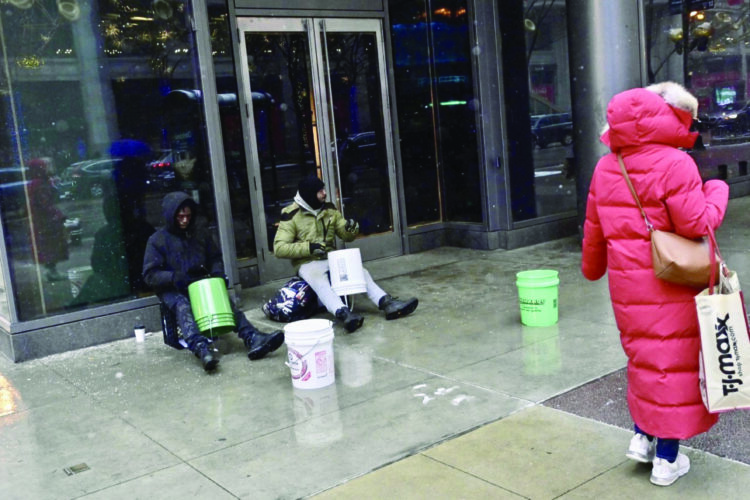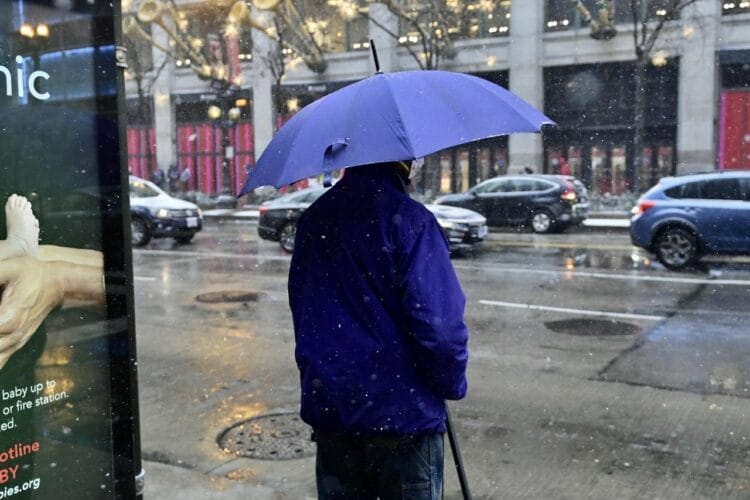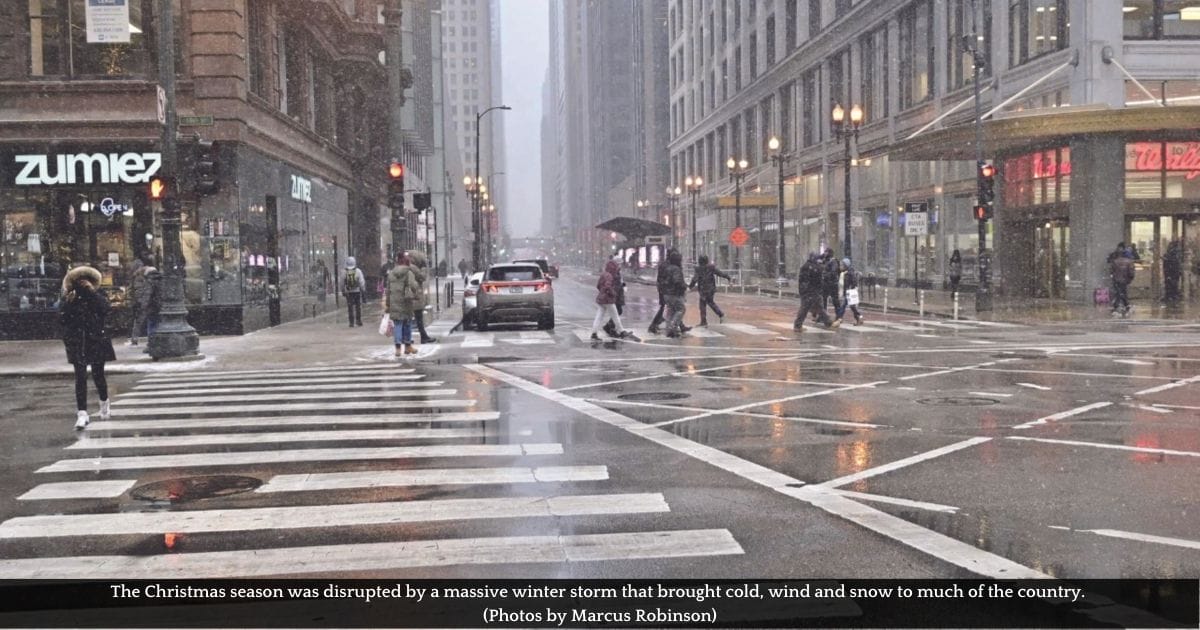The monstrous winter storm that impacted most of the nation over the Christmas weekend has killed at least 60 people and snarled travel during one of the busiest travel periods. The aftermath is a stark reminder to the country’s most vulnerable communities to know the risk, stay prepared and become more resilient.
Illinois has long engaged in preparedness training for residents and organizations to mitigate the impact of natural disasters and incidents instigated due to human error. In 1995, 793 Chicagoans lost their lives during a five-day heatwave. The heatwave also heavily impacted the wider Midwestern region, with additional deaths in both St. Louis, Missouri, and Milwaukee, Wisconsin. Ten years later, Hurricane Katrina, a catastrophic Category 5 hurricane, caused over 1,800 fatalities and $125 billion in damage in late August 2005.
This year’s winter storm is yet another reminder that severe weather can happen at any time of the year–and without warning–and that Black residents are most at risk of death or serious injury. Anndel Taylor, 22, a Black woman, was found dead in Buffalo, New York, over the holiday weekend after getting trapped in her car by the blizzard on her way home from work, her family said. The first fatality reported in that city was of William ‘Romello’ Clay, an African American father, who attempted to walk to a neighborhood store to purchase supplies.

Preparing for floods, tornadoes, snowstorms, and severe thunderstorms before they strike can help people stay safe throughout the year and reduce the need to venture out once a storm hits.
U.S. preparedness experts and safety advocates recommend each household should develop an emergency response kit in order to keep family and pets safe during weather-related emergencies. According to Ready.gov, people are encouraged to assemble their kits in airtight plastic bags and store them in one or two easy-to-carry plastic bins or duffel bags.
According to Homeland Security, a basic emergency supply kit should include the following recommended items: Water (one gallon per person per day for several days, for drinking and sanitation); food (at least a several-day supply of non-perishable items); a battery-powered or hand crank radio and an NOAA Weather Radio with tone alert; a flashlight; a first aid kit; extra batteries; a whistle (to signal for help); a dusk mask (to help filter contaminated air); plastic sheeting and duct tape (to shelter in place); moist towelettes; garbage bags and plastic ties (for personal sanitation); wrench or pliers (to turn off utilities); a manual can opener (for food); a local map; and a cell phone with chargers and a backup battery.
In addition, officials also remind people to have a 90-day supply of prescription medicine; an extra set of glasses and contact lenses; baby formula; pet food; cashier’s or traveler’s checks; and electronic or copies of important family records and documents, such as birth certificates, social security cards, insurance policies, and banking records.
In some cases, Homeland Security officials encourage people to develop at least three such kits “since you do not know where you will be when an emergency occurs, prepare supplies for home, work and cars,” the agency said.
The Federal Emergency Management Agency (FEMA) recommends that at least one household member is trained in basic first aid to recognize and treat suffocation, hypothermia, traumatic injury, and shock. In September of this year, the agency launched a series of public service announcements developed specifically to reach Black and African American communities.
Atrocities African Americans encountered while trying to survive and recover from disasters have been well documented over the course of recorded U.S. disaster history – from the San Francisco Earthquake (1906), to the Great Mississippi Flood (1927), and Hurricanes Floyd (1999) and Katrina (2005).
“Black and African American communities often suffer disproportionate impacts from disasters. This is something that we must work to change and that starts with how we prepare,” said FEMA Administrator Deanne Criswell. “Our 2022 Ready Campaign speaks directly to the communities who need our help the most and who deserve equitable access to preparedness resources that protect people and property. By continuing to advance accessibility and cultural competency in our preparedness messaging, we can make sure that everyone is ready when disaster strikes.”
A report from the Environmental Protection Agency shows that socially vulnerable populations, including Black and African American communities, may be more exposed to the highest impacts of extreme weather events. Specifically, with global warming, Black and African American individuals have a 10 percent higher risk of living in areas with the highest projected inland flooding damages compared to reference populations.
The U.S. National Weather Service warns people to remember the mantra, “Get In, Get Down, Cover Up” as a way to mitigate injury and death due to dangerous weather conditions. “If you are outside, get inside. If you’re already inside, get as far into the middle of the building as possible,” an advisory warns. “Get down and get underground if possible. Cover up because there may be flying and falling debris which is a storm’s number one killer.”
If caught outside during severe thunderstorms, people should immediately take shelter in a sturdy enclosed building or hard-top automobile. Avoid open spaces, isolated objects, high ground, and metallic objects. Get out of boats and away from bodies of water.
For more tips, people can order free preparedness materials from FEMA’s online ordering platform.
This week, U.S. Senate Majority Whip Dick Durbin (D-IL) announced that the Post-Disaster Mental Health Response Act was signed into law by President Biden as part of the Fiscal Year (FY) 2023 National Defense Authorization Act (NDAA). The bill would expand federally funded mental health and trauma support resources for survivors and first responders following Emergency Declarations granted by FEMA.
“Disasters, whether in the form of tornadoes, hurricanes, wildfires, or mass violence, can cause emotional and mental scars that have lasting effects beyond the physical damage. Communities impacted by a disaster deserve access to trauma and mental health services to cope with the aftermath and rebuild their lives,” said Durbin. “I’m grateful for the work my colleagues Senator Portman and Congresswoman Pressley did to get the Post-Disaster Mental Health Response Act to President Biden’s desk. I’m thrilled it is now law so that more communities can access mental health services.”
“When disaster strikes – whether it be a natural disaster or mass violence – survivors are often left grappling with lasting trauma that has devastating impacts on their mental health. But too often, critical mental health services offered by FEMA to cope with these tragedies are inaccessible,” said Rep. Ayanna Pressley, a member of the Congressional Black Caucus.
Currently, FEMA’s Crisis Counseling Assistance and Training Program (CCP) is only available following Major Disaster Declarations, but not Emergency Declarations. This legislation would amend the FEMA statute to give states the option to request federal reimbursement after emergency declarations for trauma and mental health services.
Following the December 2021 tornadoes in Illinois, FEMA issued an emergency declaration—if this bill had been in effect, the state could have requested CCP services, including for the survivors of the six deceased or the others injured, including first responders. Over the last decade, there have been more than 4,000 Emergency Declarations in 37 states, according to FEMA’s database. Emergency declarations have been issued for winter storms and hurricanes, as well as in times of terrorism response, such as the Boston Marathon bombing in 2013.
Chicago has long prepared for winter storms. The deadliest storm of record dates to 1967 when 60 people lost their lives after the city was shut down by a surprise blizzard that lasted for two days. The storm struck northeast Illinois and northwest Indiana on January 26–27, 1967, with a record-setting 23 inches of snowfall in Chicago and its suburbs before the storm abated the next morning. As of 2022, it remains the greatest snowfall in one storm in Chicago history.

According to the National Weather Service, in 1967 at least 20,000 cars and 1,100 CTA buses were stranded. Helicopters were used to deliver medical supplies to hospitals. “Expectant mothers were taken to hospitals by sled, bulldozer, snowplow,” researchers noted. “At least a dozen babies were born at home. Looting became a problem on the West and near the South sides of the city. Another problem in the aftermath of the storm was low supplies of heating oil. Trucks couldn’t get access to buildings.
“By the time it was over, 60 people were dead and there was an estimated $150 million in business losses (about $904 million in 2006 dollars). The 1967 snowstorm probably caused the biggest disruption to the commerce and transportation of Chicago of any event since the Great Chicago Fire of 1871,” the weather reporting agency wrote.
Dr. John Cooper, co-author of the book “Planning for Community Resilience,” said, “Those who study disasters in the U.S. have known for decades that some suffer disproportionately due to the impacts of disasters. Disasters don’t discriminate of course, but the vestiges of historic discrimination in the U.S. have consigned many African Americans, in particular, to live in high-risk flood plains and/or substandard housing less able to withstand the extreme forces of a tornado or hurricane.”
Experts predict the number and severity of natural disasters that are expected to increase over the next hundred years due to climate change.
Reporting made possible by the Inland Foundation.






